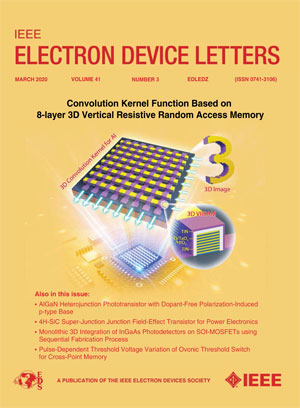Enhancement of Ferroelectricity in Hf0.5Zr0.5O2 via Pre-Crystallization and Interface Engineering at Ultra-Low Temperature (300 °C) Annealing
IF 4.1
2区 工程技术
Q2 ENGINEERING, ELECTRICAL & ELECTRONIC
引用次数: 0
Abstract
The interface degradation between ferroelectric film and surrounding layers limits the endurance of hafnia ferroelectric devices significantly. This letter proposes a promising TiN/TZHZT/TiN structure with TiO2/ZrO2 bi-interlayers on both sides of a sub-7 nm Hf0.5Zr0.5O2 (HZO). The TZHZT sample underwent ultra-low temperature annealing at超低温(300℃)退火下Hf0.5Zr0.5O2预结晶和界面工程增强铁电性
铁电薄膜与周围层之间的界面退化严重限制了半氟铁电器件的寿命。这封信提出了一个有前途的TiN/TZHZT/TiN结构,在sub-7 nm的Hf0.5Zr0.5O2 (HZO)的两侧有TiO2/ZrO2双中间层。TZHZT样品在$300~^{\circ}$ C下进行超低温退火,表现出优异的铁电性能,即显著的残余极化($2{P}_{r} = 28.2~\mu $ C/cm ${}^{{2}}\text{)}$,适当的矫顽场(${E}_{C} =1.7$ MV/cm),以及超过$10^{{10}}$循环的优异续航能力。这是双夹层工程协同作用的结果。具体来说,ZrO2中间层通过种子晶的形成促进铁电晶粒的生长,导致退火后晶粒尺寸增大。同时,TiO2夹层增强了拉伸应力和氧富集,从而提高了$2{P}_{r}$和耐久度。此外,ZrO2夹层有效地弥补了TiO2层击穿强度的不足。
本文章由计算机程序翻译,如有差异,请以英文原文为准。
求助全文
约1分钟内获得全文
求助全文
来源期刊

IEEE Electron Device Letters
工程技术-工程:电子与电气
CiteScore
8.20
自引率
10.20%
发文量
551
审稿时长
1.4 months
期刊介绍:
IEEE Electron Device Letters publishes original and significant contributions relating to the theory, modeling, design, performance and reliability of electron and ion integrated circuit devices and interconnects, involving insulators, metals, organic materials, micro-plasmas, semiconductors, quantum-effect structures, vacuum devices, and emerging materials with applications in bioelectronics, biomedical electronics, computation, communications, displays, microelectromechanics, imaging, micro-actuators, nanoelectronics, optoelectronics, photovoltaics, power ICs and micro-sensors.
 求助内容:
求助内容: 应助结果提醒方式:
应助结果提醒方式:


